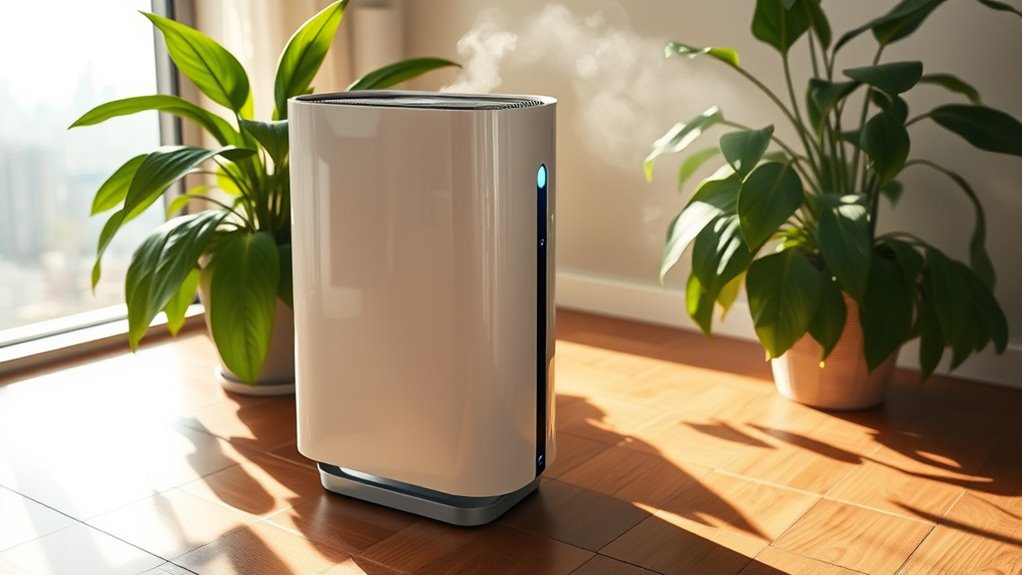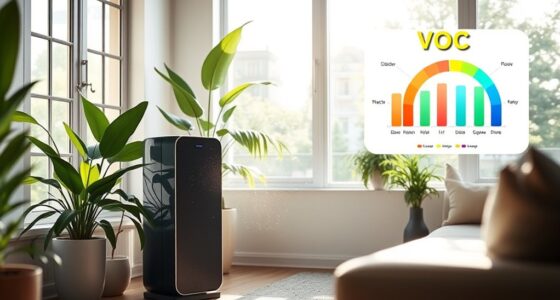Air purifiers can improve indoor air quality, but they’re often misunderstood. Many assume they lower humidity, which isn’t true. Noise, room size compatibility, and filter types matter, too. For effective performance, check CADR ratings, maintain filters, and replace them regularly—neglecting this can drop efficiency by up to 40%. Also, you might be surprised by the cost of replacements and their long-term impact. Discover more about selecting the right air purifier for your specific needs.
Key Takeaways
- Air purifiers do not reduce humidity levels; they solely improve indoor air quality by filtering pollutants.
- CADR ratings are crucial; ensure your air purifier matches the room size for optimal performance.
- Washable filters may not capture small particles as effectively as HEPA filters, impacting air quality.
- Regular filter replacement is essential; a dirty pre-filter can reduce effectiveness by up to 40%.
- Ionizing models might emit ozone, which can harm respiratory health; choose wisely based on your needs.
Debunking Common Myths About Air Purifiers
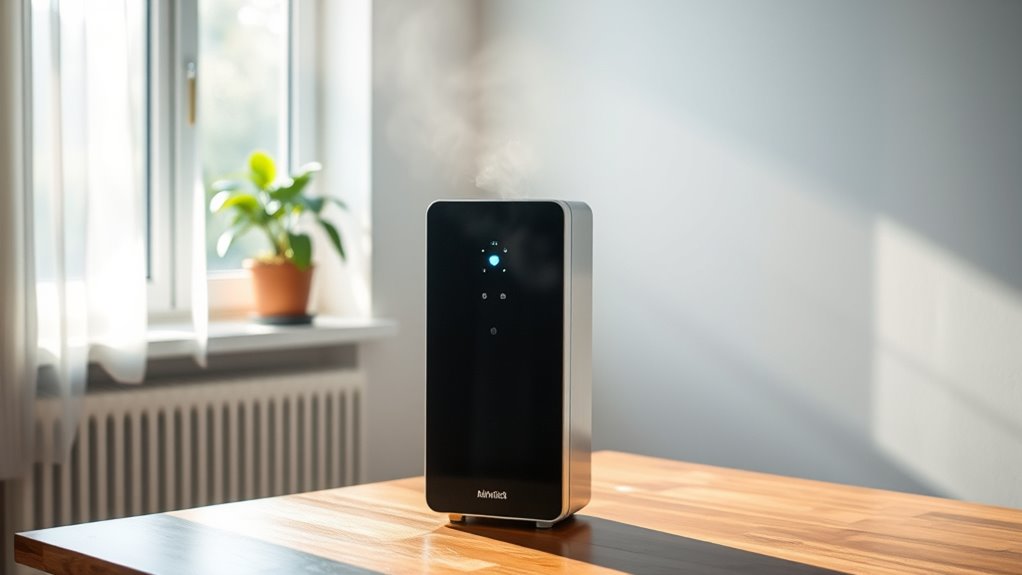
Have you ever wondered what misconceptions surround air purifiers? Many myths about air purifiers can mislead you.
First, air purifiers come to improve indoor air quality by filtering out airborne pollutants, but they don’t lower humidity levels. That’s a job for dehumidifiers. Moreover, the effectiveness of air purifiers can vary significantly based on the room size they are used in, and CADR ratings can help determine their efficiency for specific spaces. The coverage area of air purifiers is an important factor to consider and can range from compact designs for small rooms to larger models effective in areas up to 915 sq. ft.. Additionally, many people overlook the benefits of hybrid units, which combine multiple filtration technologies for enhanced air quality.
Another common myth is that washable air purifiers work as well as HEPA filters; they don’t capture small particles effectively and lose performance after washing.
Additionally, while some units emit low radiation, ionizing models may emit ozone, which can cause respiratory issues.
Remember, HEPA filters are your best bet for clean air, trapping 99.97% of dust and other pollutants. Regular filter replacement is essential for maintaining air quality and ensuring effective performance.
Don’t let these myths cloud your understanding of air cleaning!
Understanding CADR Ratings and Room Size Compatibility
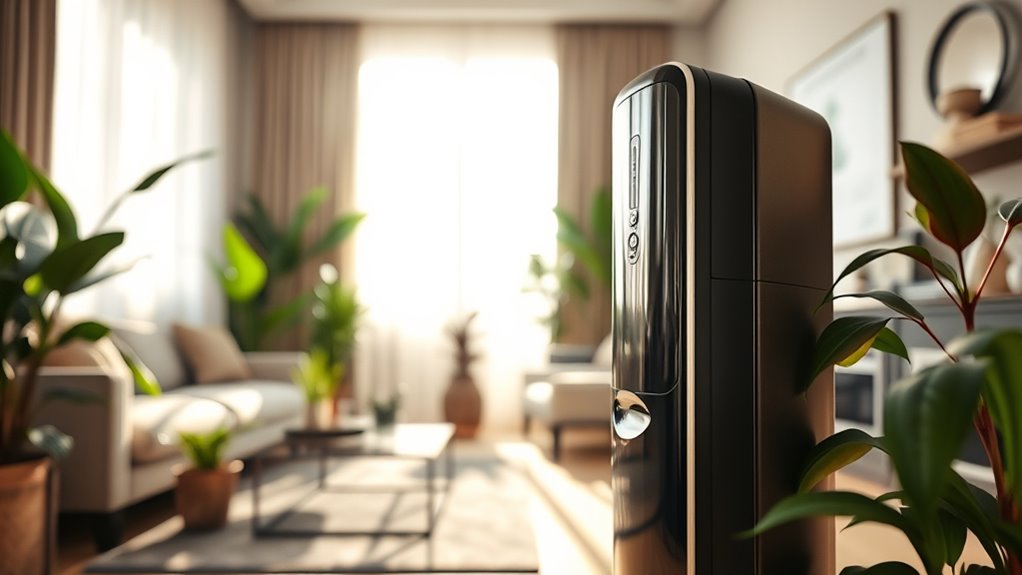
When selecting an air purifier, understanding CADR ratings is essential for ensuring you choose a model that fits your space effectively.
CADR, or Clean Air Delivery Rate, measures how well air purifiers remove specific pollutants like dust, pollen, and smoke. High CADR ratings can significantly improve overall air quality in your home. Regular filter cleaning and replacement are crucial for maintaining optimal CADR performance. Additionally, leveraging imagination can inspire innovative solutions to enhance your home environment.
CADR, or Clean Air Delivery Rate, indicates the effectiveness of air purifiers in eliminating pollutants such as dust, pollen, and smoke.
For small rooms under 200 square feet, look for a CADR of at least 150 CFM, while medium rooms (up to 400 sq. ft.) need around 260 CFM. Additionally, filter maintenance is crucial to ensure the air purifier operates at its optimal CADR performance.
If you’re dealing with large spaces over 400 square feet, opt for a unit with a CADR score exceeding 300 CFM for adequate air quality. Always verify room size claims from independent sources, as many manufacturers’ marketing may not accurately reflect the air cleaning performance based on CADR rather than filter grade. Regular cleaning and monitoring air quality indicators can also enhance your air purifier’s effectiveness in maintaining a healthy environment.
The Importance of Filter Maintenance and Replacement Costs
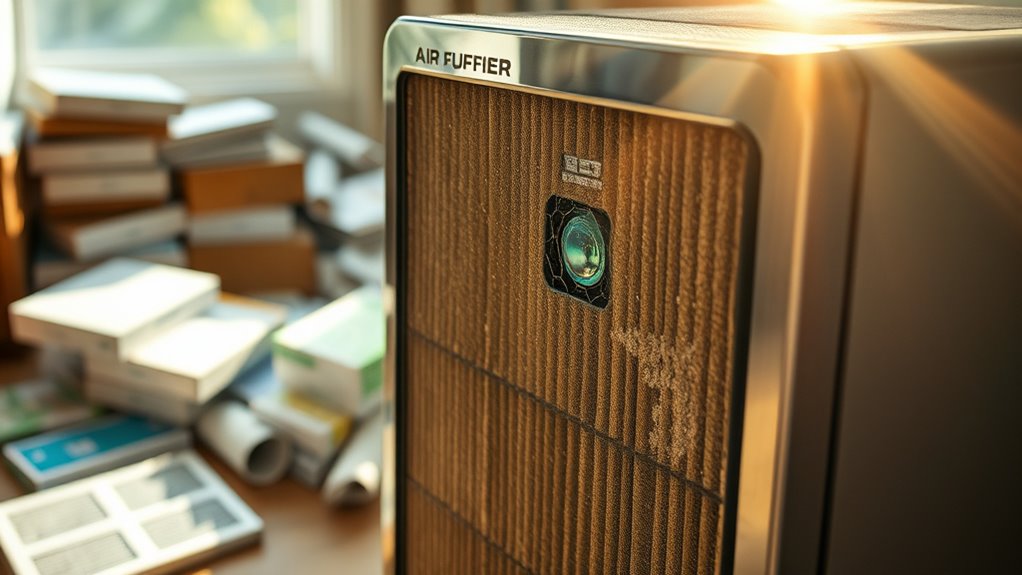
Maintaining your air purifier’s filters is essential not just for efficiency but also for managing long-term costs. Regular filter maintenance guarantees that your air purifier operates at peak efficiency; a dirty pre-filter can reduce effectiveness by up to 40%. Additionally, energy efficiency ratings can help you choose the best air purifier model that will save you money over time.
When budgeting for your air purifiers, consider both the replacement costs of HEPA filters and pre-filters. Some models come with long-lasting filters, which can lower the frequency and overall cost of replacements, making them more economical. Furthermore, HEPA filters are designed to remove 99.97% of airborne pollutants, ensuring that you maintain clean air in your home. Moreover, heat pumps typically consume less energy than traditional systems, emphasizing the importance of choosing energy-efficient appliances. Additionally, a well-planned budget can help you allocate funds towards the maintenance and replacement of filters, ensuring affordability over time.
Additionally, think about energy consumption—higher efficiency models may have higher initial filter prices, but they can lead to lower operational costs over time. Smart budget planning around filter maintenance can save you money while guaranteeing clean, healthy air. Proper cleaning after each use ensures optimal performance and longevity of your air purifier’s filters.
Exploring the Health and Productivity Benefits of Clean Air
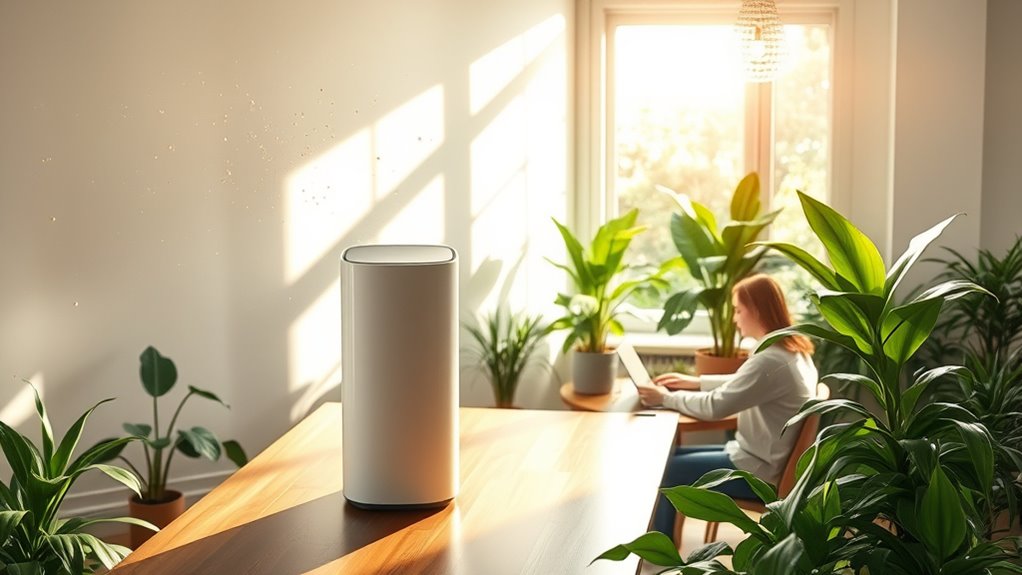
Clean air isn’t just a luxury; it’s essential for your health and productivity. High-performance air purifiers using HEPA air technology effectively remove airborne particles and pollutants, leading to enhanced overall health. You’ll notice reduced respiratory issues, which contributes to your well-being. Improved air quality in indoor environments is linked to better cognitive function and focus, boosting your productivity. Furthermore, home improvements for seniors can create an environment that promotes better air circulation, enhancing these benefits. Regular maintenance of air purifiers, including routine inspections, can help ensure they operate at peak efficiency. Additionally, studies suggest that tea consumption can further support respiratory health by providing antioxidants that combat pollution effects. In addition, utilizing eco-friendly practices such as burning dry, seasoned wood in wood stoves can significantly improve indoor air quality and complement the benefits of air purifiers.
Studies show that cleaner air can greatly enhance workplace mental clarity, making it easier to tackle tasks efficiently. Additionally, removing cooking-generated pollutants elevates your culinary experience, improving flavor perception. Plus, minimizing dust accumulation in electronics prevents overheating, ensuring peak device performance and supporting your productivity in the long run. Prioritizing clean air is truly a game-changer for your day-to-day life. Furthermore, energy-efficient models can significantly reduce heating and cooling costs, making clean air solutions even more beneficial for your overall budget.
Choosing the Right Air Purifier for Your Needs
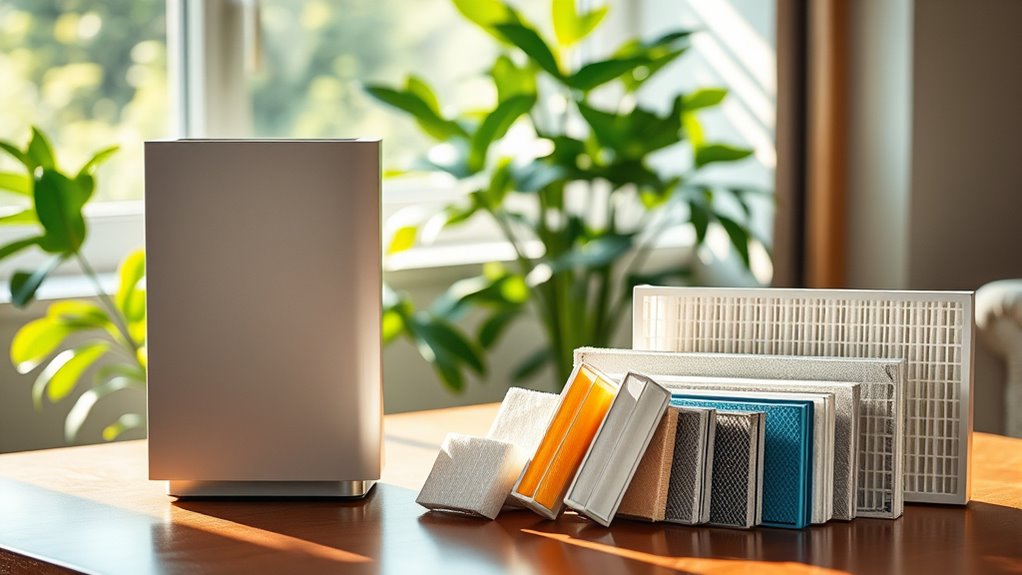
How do you choose the right air purifier for your specific needs? Start by examining the Clean Air Delivery Rate (CADR). For small rooms, look for at least 150 CFM, and for larger spaces, over 300 CFM is ideal.
Opt for air purifiers with HEPA filters, which trap 99.97% of airborne particles, ensuring better indoor air quality by removing allergens and fine matter. Consider the size; larger units usually perform better at lower speeds, reducing noise while enhancing performance.
Additionally, select models with removable pre-filters to capture larger particles, prolonging the life of main filters. Finally, keep an eye on the cost of replacement filters, as frequent changes can greatly impact your long-term cost of ownership.
Frequently Asked Questions
Is There Anything Bad About Air Purifiers?
Yes, there are some downsides to air purifiers. Certain models, especially those using ionizing technology, can emit ozone, which isn’t good for your health.
Washable purifiers often lack HEPA filters, so they mightn’t capture smaller particles effectively. If you don’t maintain or replace filters regularly, their efficiency drops over time.
Additionally, some purifiers produce EMF radiation, and costs for replacements can add up, making them less economical in the long run.
What Are the Dark Side of Air Purifiers?
When you think about air purifiers, it’s easy to overlook their downsides. You might find that some emit ozone, which can harm your lungs.
Washable filters could underperform after a few cleans, making you question their value. Plus, you may face recurring costs from frequent filter replacements.
Misleading marketing could lead you to buy a unit that’s too weak for your space, leaving you with stale air instead of freshness.
What Do Doctors Say About Air Purifiers?
Doctors highly recommend air purifiers, especially those with HEPA filters, for improving indoor air quality. They capture 99.97% of airborne particles, which means you’re breathing cleaner air.
If you have asthma or allergies, using an air purifier can greatly reduce your symptoms and enhance your overall health. The EPA also supports their use, particularly in poorly ventilated spaces, making them a smart choice for maintaining a healthier home environment.
Do Home Air Purifiers Really Make a Difference?
Yes, home air purifiers really do make a difference. They trap 99.97% of airborne particles, including allergens like pollen and dust, improving your indoor air quality markedly.
With a HEPA filter, you’re capturing even the tiniest harmful particles. Better air quality can enhance your cognitive function and boost productivity, helping you think clearer.
Plus, they won’t dry out the air, so you can breathe easy and feel comfortable at home.
Conclusion
In your quest for cleaner air, remember that not all air purifiers are created equal—like knights in shining armor, some truly protect your health while others merely look the part. By understanding CADR ratings, maintenance costs, and choosing wisely, you can transform your space into a sanctuary. So, as you breathe in that fresh air, think of it as your own personal oasis, where productivity flourishes and well-being reigns supreme. Your lungs will thank you!
